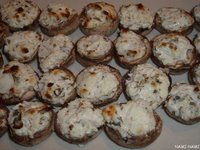On the table were:
 Potatoes with lemon and garlic (Kreeka sidrunikartulid) - simply boiled potatoes, tossed with olive oil, chopped garlic, salt and lemon juice at the end.
Potatoes with lemon and garlic (Kreeka sidrunikartulid) - simply boiled potatoes, tossed with olive oil, chopped garlic, salt and lemon juice at the end. Feta and spinach mini omelettes (Feta-spinati miniomletid) that I have made couple of times before and went down a storm.
Feta and spinach mini omelettes (Feta-spinati miniomletid) that I have made couple of times before and went down a storm. Roasted mushrooms (Täidetud seenekübarad), this time stuffed with some Welsh goat cheese, grated parmesan and chopped parsley.
Roasted mushrooms (Täidetud seenekübarad), this time stuffed with some Welsh goat cheese, grated parmesan and chopped parsley. Black Greek kalamata olives with garlic and herbs
Black Greek kalamata olives with garlic and herbsIn addition to the above, I cooked two new dishes, both from Tessa Kiros' beautiful book Falling Cloudberries: A World of Family Recipes
Oven-baked fish with tomato and parsley
(Kreeka kalavormi retsept)
Serves 4-6
1 kg white fish fillets (I used haddock), cut into 5-6 cm pieces
400 grams chopped tomatoes with juice
a generous handful of chopped flat-leaf parsley
4 large garlic cloves, finely chopped
juice of 2 lemons
2 celery stalks, chopped with some leaves
1 tsp sugar
3 Tbsp olive oil
salt and crushed black pepper
 Put fish fillets into a large oven dish in a single layer. Sprinkle with Maldon salt flakes and crushed black pepper.
Put fish fillets into a large oven dish in a single layer. Sprinkle with Maldon salt flakes and crushed black pepper.Mix tomatoes, parsley, garlic, lemon juice, celery, sugar and olive oil. Season to taste and spoon over the fish fillets to cover completely.

Cover with foil and cook for 30 minutes at 180˚C.
Remove the foil, increase the heat to 200˚C and cook for another 40-50 minutes, or until the liquid has thickened and the top of the fish is golden in a couple of places. (To be honest, I cooked it for 30 minutes under the foil and then just another 15 minutes more.
 I would have preferred the liquid slightly more thick, but the fish was beautifully cooked and according to my friend Anna, Greek sauces would always be a bit soupy rather than sticky). The taste was perfect, it felt (and probably was) very light and flavoursome.
I would have preferred the liquid slightly more thick, but the fish was beautifully cooked and according to my friend Anna, Greek sauces would always be a bit soupy rather than sticky). The taste was perfect, it felt (and probably was) very light and flavoursome.Serve with a crusty bread to mop up the juices. According to the author, "this dish is great served either hot or cold, even straight from the fridge".
Purkouri - Cracked Wheat
(Küprose bulgurisalat)
This is from the "Cyprus" chapter of the book, and probably Turkish in origin, as it reminds me a lot of a dish, kisir, that my former Turkish flatmate Fatosh prepared regularly. Tessa Kiros writes that "This is good as part of a vegetarian meal, or instead of rice or potatoes with something like a simple grilled chicken breast."
Serves 4-6 as a side dish.

4 Tbsp olive oil
1 red onion, finely chopped
2 garlic cloves, finely chopped
200 grams chopped tomatoes (I used 400 grams)
265 grams bulgur/cracked wheat (I used medium)
1 tsp paprika powder
750 ml boiling water
salt & pepper
Heat the oil in a heavy saucepan, sauté onion until soft. Add the garlic, sauté for a minute or two before adding the tomatoes. Heat until tomatoes are bubblying.
Add the cracked wheat, season with salt and pepper and mix through.
Add the paprika and boiling water. Bring to the boil, reduce the heat, half-cover the saucepan with a lid and simmer for 10 minutes. Gently stir every now and then.
Take the saucepan off the heat, cover with a clean teatowel and the lid. Let it steam off for 10 minutes or so.
Fluff up. Serve warm or room temperature with a dollop of yogurt, if wished. (I omitted the yogurt and added a generous sprinkling of parsley).
* It was a mixed bunch: nationalities present were Greek (1), Turkish (1), Korean (2), South African (1), Estonian (1) - just as colourful as the food:)


































